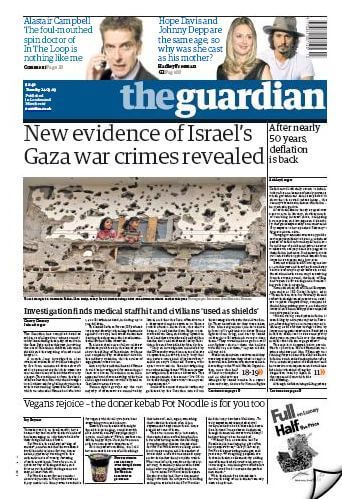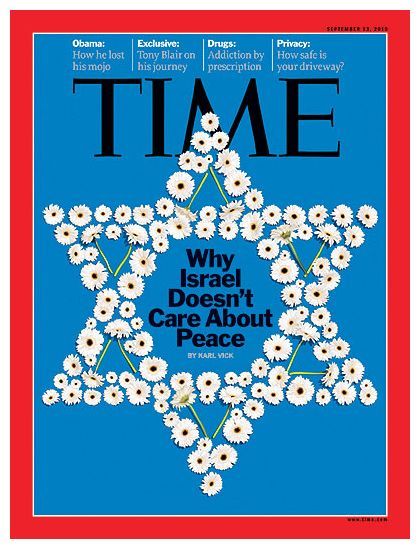Part two of an eight-part series explaining The 8 Categories of Media Bias.
Violation #2
Imbalanced Reporting
Journalism distorts news through disproportionate coverage, presenting only one side of the story, or misrepresenting fringe views as mainstream.
For purposes of journalism, balance is defined as
A state in which different things occur in equal or proper amounts or have an equal or proper amount of importance
Imbalance can come in many forms, such as articles quoting several Palestinians at length but only one Israeli (often, only briefly), sites where the balance of op-eds, letters and talk backs are overwhelmingly critical of Israel, one-sided photo essays, and misrepresenting fringe views as mainstream.
Proportionate coverage is an aspect of balance. When editors package a particular story with extra graphics, related commentary, an interactive feature, and a social media conversation, they’re attaching importance to the issue. Other stories are only worth a quick paragraph in a bulleted digest.
Prominence is another aspect of balance. Not every new development warrants front page attention. Burying, or ignoring important news would be the flip side of disproportionate coverage.
Watch the Jerusalem Post’s Steve Linde and Gil Hoffman, and Dan Diker of the Jerusalem Center for Public Affairs discuss imbalanced reporting with HonestReporting.
A few example of the breakdowns highlight the different facets of what makes reporting “balanced.”
Since this was first published, new examples have been added.
EXAMPLE: In 2009, Breaking the Silence, a non-governmental organization that claims to expose IDF misconduct, issued a report alleging abuses by the military during Operation Cast Lead. The soldiers’ testimonies were discredited as hearsay and rumor. Any journalist reading the organization’s report should have noticed it was problematic. But the British media gave Breaking the Silence disproportionate attention.
The Independent, for example, published a front page double-center spread whose lead article was more than 48 column inches. The online article also linked to Breaking the Silence’s web site. And The Guardian, in addition to its front page main story, posted three videos, a column, and a staff-editorial.

EXAMPLE: BBC News came under attack after the Itamar massacre of 2012, when Palestinian terrorists brutally murdered Udi and Ruth Fogel and three of their children. The BBC didn’t report the story at all, raising the ire of then-British MP Louise Bagshawe. BBC officials apologized.
EXAMPLE: A Time magazine cover-story in Sept. 2010, titled “Why Israel Doesn’t Care About Peace” spun Israelis as disinterested in peace and detached from the Mideast conflict. For a story of such heft, Jerusalem bureau chief Karl Vick needed a representative cross-section of Israeli views. Instead, the article was based on the views of two Russian-born salesmen, an elderly woman, and her waitress friend — all in Ashdod.
Moreover, those four were outnumbered by five “talking heads” — Israeli politicians, pundits, activists and academics.
(HonestReporting readers awarded Time the 2010 Dishonest Reporter Award for this.)

EXAMPLE: In the guise of “balanced reporting,” the Western media is especially fond of quoting news and opinions from the left-wing Israeli paper, Haaretz. The paper’s staff and contributors are entitled to their views, but Western readers are given a distorted image of Israel when Haaretz is wrongly portrayed as “mainstream.” Seth Frantzman, a senior editor at the rival Jerusalem Post explains why:
Amos Schocken wrote a personal appeal in May of 2014 to readers telling them not to unsubscribe for patriotic reasons. “You will become a partner in the ongoing effort to shape Israel as a liberal and constitutional democracy that cherishes the values of pluralism and civil and human rights” by subscribing, he claimed. When taken to task by Richard Silverstein at the Tikun Olam blog for passing off a newspaper as a sort of Soviet style loyalist Pravda of the state, Schocken responded on Twitter “typical of leftists, more busy showing their own who is more leftist than aiming at the right.” The essence was that Haaretz is part of a 1930s style crusade against the right, like the ideologues of the Spanish Civil War ‘no pasaron’, Haaretz will hold the line . . .
The main problem with those reading Haaretz abroad is they don’t understand the conversation they are joining when they read Haaretz. They think they are reading about Israel from a center-left publication, similar to the major newspapers of record abroad, such as the ‘Times’, El Pais, Corriere Della Serra, Le Monde, or Die Welt. But while all these newspapers certainly have political ideologies and reader bases that reflect certain socio-economic and racial demographics, they are nowhere near as insular as Haaretz.
To understand Haaretz, one must understand that its circulation rate in Israel is in the single digits as a percent of the population (20-30,000 readers in print, compared to the largest daily, Yediot, which is read by an estimated 60 percent of Israelis), and that it is read by and written for and within the milieu of a narrow-minded, extremist group. This was referenced above in noting that the early owners and writers were decidedly “European” in their culture and in wanting to preserve “European” culture in the “jungle” of the Middle East.
 EXAMPLE: Assessing New York Times coverage of the Mideast conflict in November, 2014, public editor Margaret Sullivan acknowledged that rigorously covering Palestinian politics and society is a blind spot for her paper even as Israel itself is over-covered.
EXAMPLE: Assessing New York Times coverage of the Mideast conflict in November, 2014, public editor Margaret Sullivan acknowledged that rigorously covering Palestinian politics and society is a blind spot for her paper even as Israel itself is over-covered.
Strengthen the coverage of Palestinians. They are more than just victims, and their beliefs and governance deserve coverage and scrutiny. Realistic examinations of what’s being taught in schools, and the way Hamas operates should be a part of this. What is the ideology of Hamas; what are its core beliefs and its operating principles? What is Palestinian daily life like? I haven’t seen much of this in The Times.
Other Examples
CNN’s over-coverage of the missing MH 370 flight aptly ridiculed by Jon Stewart, the UK media’s over-the-top royal baby vigil, Hungarian media being instructed not to broadcast images of refugee children in Europe, and a White House ban on coverage of US military coffins returning from Iraq.
The Forward’s 24-hour moratorium on Donald Trump coverage, partly to draw attention to what editor Jane Eisner argued was the media’s imbalanced reporting:
But our Trumpatorium is also an acknowledgement of the role the media has, even unwittingly, played in elevating the worst in the Trump campaign. By first treating the campaign as a reality show instead of a serious challenge to the democratic order, we enabled the candidate to skirt substantive questions about his proposals and gloss over inconsistencies and lies. We amplified the name-calling and insults, focusing on polls and the political horse race instead of fitness and character. We gave him what seemed like unlimited air time, ignoring the old rules of fairness and balance. We let him do what he does best: define the world in his terms, civic consequences be damned.
Click to learn more about each individual category.
The 8 Violations of Media Objectivity
- Misleading definitions: Prejudicing readers through language.
- Imbalanced reporting: Distorting news through disproportionate coverage.
- Opinions disguised as news: Inappropriately injecting opinion or interpretation into coverage.
- Lack of context: Withholding a frame of reference for readers.
- Selective omission: Reporting certain events over others, or withholding key details.
- Using true facts to draw false conclusions: Infecting news with flawed logic.
- Distortion of facts: Getting the facts wrong.
- Lack of transparency: Failing to be open and accountable to readers.
See also the introduction to this series and some final thoughts and acknowledgements, wrapping the concepts together and raising awareness for news literacy.
“Red Lines: The Eight Categories of Media Bias,” is available on Amazon for purchase as an e-book.
Before you comment on this article, please remind yourself of our Comments Policy. Any comments deemed to be in breach of the policy will be removed at the editor’s discretion.

